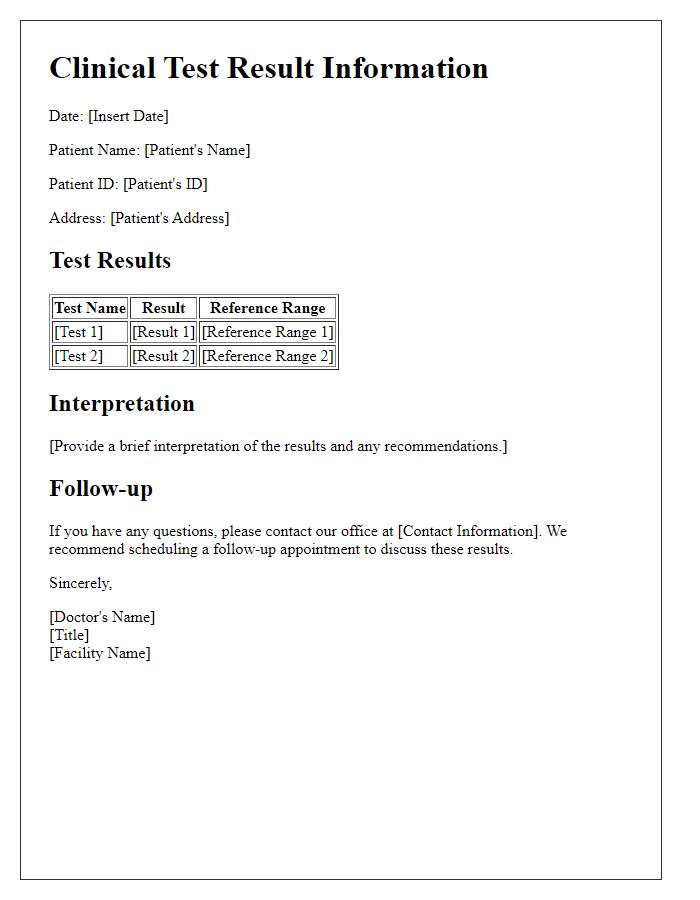Are you expecting lab test results and feeling a mix of anticipation and anxiety? It's completely normal to wonder what the outcomes might reveal about your health. This letter template is designed to ease the process by providing clear communication about your test results and what they mean moving forward. Curious about how to effectively communicate this information? Read on to discover the best practices for notifying individuals about their lab results with compassion and clarity.

Clear Subject Line
Lab test results notifications should include essential information clearly and concisely. A clear subject line such as "Your Lab Test Results are Ready" helps recipients quickly understand the purpose of the email. Inside the message, include critical details like the tests conducted (e.g., blood work, urinalysis), the date the tests were performed (e.g., October 1, 2023), and any necessary follow-up actions (e.g., contacting a healthcare provider). Ensure the tone remains professional yet compassionate, addressing any potential concerns related to results. Provide contact information for clarification to enhance patient support.
Patient Identification Information
Lab test results notification serves as a crucial communication channel between healthcare providers and patients, ensuring that individuals receive timely information about their health status. Patient identification information includes essential details like full name, date of birth, and medical record number, which are vital for accurately associating test results with the correct individual. Lab tests, such as blood work or biopsies, may involve complex analyses that provide insights into various health conditions, including diabetes or cancers. Laboratories follow strict protocols to ensure accuracy and confidentiality, with results being communicated through secure platforms or direct contact from healthcare professionals. This notification process highlights the importance of clear communication in the healthcare system, enabling patients to take informed actions based on their test outcomes.
Lab Test Details
Lab test details encompass various crucial elements, including patient information (name, ID, date of birth), test type (such as Complete Blood Count or CBC, Glucose Tolerance Test, etc.), collection date and time (specific timestamps), results release date (indicating when the lab analysis is finalized), and reference ranges (noting normal and abnormal values). Laboratory accreditation (e.g., CLIA-certified) assures compliance with regulations, while the physician's name facilitates follow-up discussions about the findings. Each test result is generally highlighted with its corresponding numerical values alongside qualitative descriptors (e.g., normal, elevated, or depressed), providing clear insights into the patient's health status and guiding further medical decisions or treatment plans.
Result Summary with Explanation
Laboratory test results indicate the levels of various biomarkers in the bloodstream. For instance, elevated cholesterol levels exceeding 240 mg/dL may suggest an increased risk of cardiovascular conditions, emphasizing the need for dietary adjustments or further medical evaluation. Conversely, low hemoglobin levels below 12 g/dL could indicate anemia, warranting investigation into potential underlying causes such as nutritional deficiencies or chronic diseases. Additionally, glucose levels, when surpassing 126 mg/dL during fasting, may raise concerns about diabetes mellitus, necessitating lifestyle modifications or pharmacological intervention. Each test result should be interpreted in conjunction with clinical history and symptoms for a comprehensive health assessment.
Contact Information for Follow-up
Lab test results notification is a crucial communication tool highlighting the importance of follow-up contact information for patients. Typically, the notification includes details such as the testing facility's name, an example being St. Mary's Medical Center located in San Francisco, California. It specifies the patient's unique identifier, like a medical record number, ensuring accurate results attribution. Clear instructions on how patients can obtain their results, such as phone numbers (e.g., 415-123-4567) for direct lines to healthcare practitioners or online portal access, enhance accessibility. Furthermore, it emphasizes the importance of contacting healthcare providers for clarifications, especially if results indicate abnormal conditions requiring immediate attention. Patient safety and timely communication form the core of this essential correspondence practice.













Comments